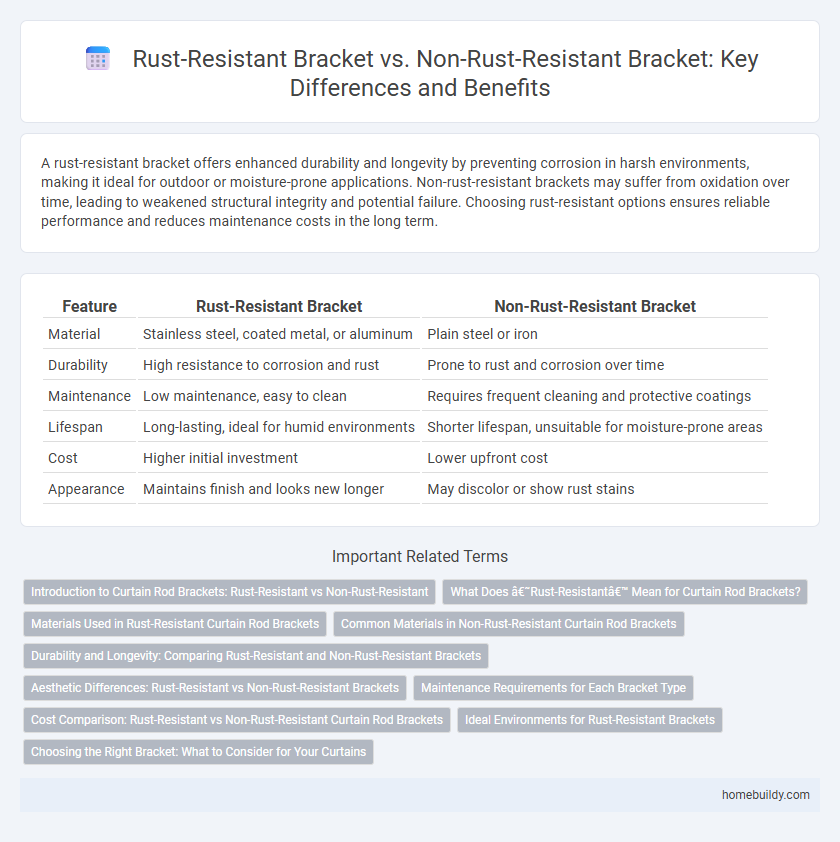A rust-resistant bracket offers enhanced durability and longevity by preventing corrosion in harsh environments, making it ideal for outdoor or moisture-prone applications. Non-rust-resistant brackets may suffer from oxidation over time, leading to weakened structural integrity and potential failure. Choosing rust-resistant options ensures reliable performance and reduces maintenance costs in the long term.
Table of Comparison
| Feature | Rust-Resistant Bracket | Non-Rust-Resistant Bracket |
|---|---|---|
| Material | Stainless steel, coated metal, or aluminum | Plain steel or iron |
| Durability | High resistance to corrosion and rust | Prone to rust and corrosion over time |
| Maintenance | Low maintenance, easy to clean | Requires frequent cleaning and protective coatings |
| Lifespan | Long-lasting, ideal for humid environments | Shorter lifespan, unsuitable for moisture-prone areas |
| Cost | Higher initial investment | Lower upfront cost |
| Appearance | Maintains finish and looks new longer | May discolor or show rust stains |
Introduction to Curtain Rod Brackets: Rust-Resistant vs Non-Rust-Resistant
Rust-resistant curtain rod brackets feature coatings such as powder coating or stainless steel materials that prevent corrosion, making them ideal for high-humidity areas like bathrooms or kitchens. Non-rust-resistant brackets, often made from plain metal, tend to degrade and weaken over time when exposed to moisture, reducing their durability and aesthetic appeal. Selecting rust-resistant brackets ensures longer-lasting support and maintains the curtain rod's structural integrity in challenging environments.
What Does ‘Rust-Resistant’ Mean for Curtain Rod Brackets?
Rust-resistant curtain rod brackets are designed with materials such as stainless steel, aluminum, or coated metals that prevent oxidation and corrosion, ensuring long-term durability in humid environments. Non-rust-resistant brackets, often made from untreated iron or low-quality metals, tend to develop rust over time, compromising both appearance and structural integrity. Choosing rust-resistant brackets enhances the lifespan and reliability of curtain rod installations, especially in bathrooms or kitchens where moisture exposure is frequent.
Materials Used in Rust-Resistant Curtain Rod Brackets
Rust-resistant curtain rod brackets are commonly made from materials such as stainless steel, aluminum, and brass, which inherently resist oxidation and corrosion. These metals often feature protective coatings like powder coating or zinc plating to enhance durability in humid environments. In contrast, non-rust-resistant brackets typically use untreated iron or low-grade steel, making them more susceptible to rust and deterioration over time.
Common Materials in Non-Rust-Resistant Curtain Rod Brackets
Non-rust-resistant curtain rod brackets are commonly made from materials such as plain steel, iron, and aluminum, which are prone to oxidation when exposed to moisture. These materials often lack protective coatings, leading to visible rust, corrosion, and reduced structural integrity over time. Choosing non-rust-resistant brackets typically results in shorter product lifespan and increased maintenance compared to rust-resistant alternatives.
Durability and Longevity: Comparing Rust-Resistant and Non-Rust-Resistant Brackets
Rust-resistant curtain rod brackets, often coated with materials like powder coating or made from stainless steel, exhibit superior durability and longevity by preventing corrosion and maintaining structural integrity over time. Non-rust-resistant brackets, typically made from untreated metals, are prone to rust formation, weakening their strength and shortening their lifespan, especially in humid environments. Selecting rust-resistant brackets ensures sustained performance and reduced maintenance, making them ideal for long-term use in various settings.
Aesthetic Differences: Rust-Resistant vs Non-Rust-Resistant Brackets
Rust-resistant curtain rod brackets maintain a smooth, clean finish over time, preserving the aesthetic appeal of window treatments. Non-rust-resistant brackets often develop discoloration and corrosion, causing unsightly stains and degrading the overall look. Choosing rust-resistant materials like stainless steel or powder-coated metal enhances durability and keeps interiors visually polished.
Maintenance Requirements for Each Bracket Type
Rust-resistant curtain rod brackets require minimal maintenance since their coatings prevent corrosion, reducing the need for frequent cleaning or replacement. Non-rust-resistant brackets often demand regular inspection and cleaning to remove rust buildup, along with occasional repainting or treatment to prolong their lifespan. Choosing rust-resistant brackets minimizes upkeep efforts and ensures long-term durability in humid or outdoor environments.
Cost Comparison: Rust-Resistant vs Non-Rust-Resistant Curtain Rod Brackets
Rust-resistant curtain rod brackets typically cost 15-30% more than non-rust-resistant options due to enhanced materials like stainless steel or powder-coated finishes that prevent corrosion. While the initial investment is higher, rust-resistant brackets reduce replacement frequency and maintenance expenses over time, offering better long-term value. Non-rust-resistant brackets may have a lower upfront price but often incur additional costs related to rust damage and shorter lifespan in humid environments.
Ideal Environments for Rust-Resistant Brackets
Rust-resistant curtain rod brackets are ideal for high-humidity environments such as bathrooms, kitchens, and coastal areas where moisture exposure is frequent. These brackets, often made from stainless steel or coated with anti-corrosive materials, maintain their structural integrity and appearance over time compared to non-rust-resistant options. Choosing rust-resistant brackets ensures durability and reduces maintenance in moist conditions, preventing unsightly rust stains and weakening.
Choosing the Right Bracket: What to Consider for Your Curtains
Rust-resistant curtain rod brackets offer superior durability and maintain aesthetic appeal even in high-humidity areas like bathrooms and kitchens, preventing unsightly corrosion and structural weakening over time. Non-rust-resistant brackets may be suitable for dry, low-moisture environments but require frequent maintenance or replacement to avoid damage and ensure safety. When choosing the right bracket for your curtains, consider the room's humidity, exposure to moisture, material longevity, and the overall quality to guarantee long-lasting support and a polished look.
Rust-resistant bracket vs non-rust-resistant bracket Infographic

 homebuildy.com
homebuildy.com